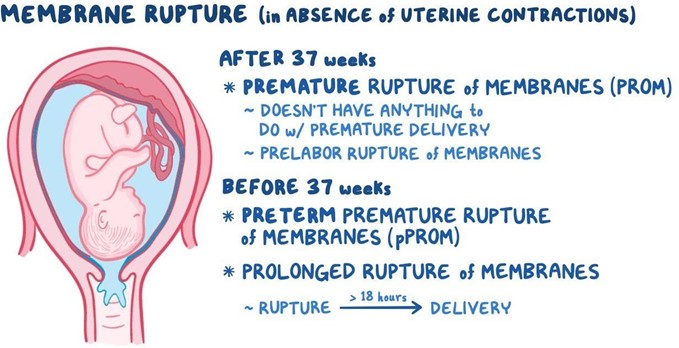A nurse is assessing a full-term newborn upon admission to the nursery. Which of the following clinical findings should the nurse report to the provider?
Rust-stained urine.
Single palmar creases.
Subconjunctival hemorrhage.
Transient circumoral cyanosis
The Correct Answer is B
The correct answer is choice B. Single palmar creases.
Choice A rationale:
Rust-stained urine is typically due to urate crystals and is common in newborns. It usually resolves on its own and is not a cause for concern.
Choice B rationale:
Single palmar creases can be associated with certain genetic conditions, such as Down syndrome. This finding should be reported to the provider for further evaluation.
Choice C rationale:
Subconjunctival hemorrhage is a common finding in newborns due to the pressure changes during delivery. It usually resolves without intervention and is not typically a cause for concern.
Choice D rationale:
Transient circumoral cyanosis is often seen in newborns and can occur when the baby is crying or feeding. It usually resolves on its own and is not typically a cause for concern.
Nursing Test Bank
Naxlex Comprehensive Predictor Exams
Related Questions
Correct Answer is C
Explanation
Umbilical cord prolapse is a medical emergency that occurs when the umbilical cord comes out of the uterus with or before the presenting part of the baby. The concern with cord prolapse is that pressure on the cord from the baby will compromise blood flow to the baby. It usually occurs during labor but can occur any time after the rupture of membranes³.
Umbilical cord prolapse can cause fetal hypoxia (lack of oxygen), bradycardia (slow heart rate), acidosis (high acidity in the blood), and death if not treated promptly. The immediate goal of management is to relieve the pressure on the cord and restore blood flow to the baby. The definitive treatment is an emergency cesarean section to deliver the baby as soon as possible¹².
While waiting for the cesarean section, the nurse should take several steps to reduce the risk of fetal
compromise, such as:
- Call for help and notify the provider
- Place the client in a knee-chest, Trendelenburg, or modified Sims position to shift the fetal weight off the
cord
- Exert continuous upward pressure on the presenting part with a sterile gloved hand to lift it away from
the cord
- Administer oxygen to the client at 8 to 10 L/min via a nonrebreather mask
- Administer IV fluids to maintain hydration and blood pressure
- Administer tocolytics (medications that stop uterine contractions) as ordered to reduce cord compression
- Monitor fetal heart rate and uterine activity continuously
- Provide emotional support and reassurance to the client and family
Exerting continuous upward pressure on the presenting part is a critical action that the nurse should take to prevent further cord compression and improve fetal oxygenation. The nurse should insert a sterile gloved hand into the vagina and gently push up on the fetal head or buttocks until delivery. The nurse should not attempt to push the cord back into the uterus or manipulate it in any way, as this could cause more damage or infection¹².
The other options are not actions that the nurse should take:
- a) Place the client in a left-lateral position for 1 hr. after administration. This is not correct because this position does not relieve the pressure on the cord. The client should be placed in a knee-chest, Trendelenburg, or modified Sims position instead.
- b) Initiate oxytocin via continuous IV infusion. This is not correct because oxytocin stimulates uterine contractions, which can worsen cord compression and fetal distress. The nurse should administer tocolytics instead to stop contractions.
- d) Request that the provider insert an intrauterine pressure catheter. This is not correct because an intrauterine pressure catheter is used to measure uterine contractions, not cord prolapse. Inserting a catheter could also increase the risk of infection or injury.

Correct Answer is D
Explanation
An indirect Coombs' test, also known as an indirect antiglobulin test, is used to detect antibodies in your bloodstream that could attach to red blood cells¹². It is used as a screening process to see how you'll react to a blood transfusion². An indirect Coombs' test is also routinely given as part of prenatal testing to see if you have antibodies against Rh-positive blood¹. If you have an Rh-negative blood type and your baby has an Rh-positive blood type, then your immune system could make antibodies that attack your baby's red blood cells¹. This can cause a condition called Rh disease, which can lead to anemia, jaundice or other serious health problems for your baby¹. The indirect Coombs' test can help prevent or treat this problem by detecting the presence of Rh-positive antibodies in your blood¹².
The other options are incorrect because they describe different tests or purposes:
a) The amount of amniotic fluid around the fetus is measured by an ultrasound scan, not by a blood test.
b) The risk of hypoglycemia (low blood sugar) after birth is assessed by measuring the baby's blood glucose level, not by a maternal blood test.
c) The blood flow in the fetus and placenta is studied by a Doppler ultrasound scan, not by a blood test.

Whether you are a student looking to ace your exams or a practicing nurse seeking to enhance your expertise , our nursing education contents will empower you with the confidence and competence to make a difference in the lives of patients and become a respected leader in the healthcare field.
Visit Naxlex, invest in your future and unlock endless possibilities with our unparalleled nursing education contents today
Report Wrong Answer on the Current Question
Do you disagree with the answer? If yes, what is your expected answer? Explain.
Kindly be descriptive with the issue you are facing.
